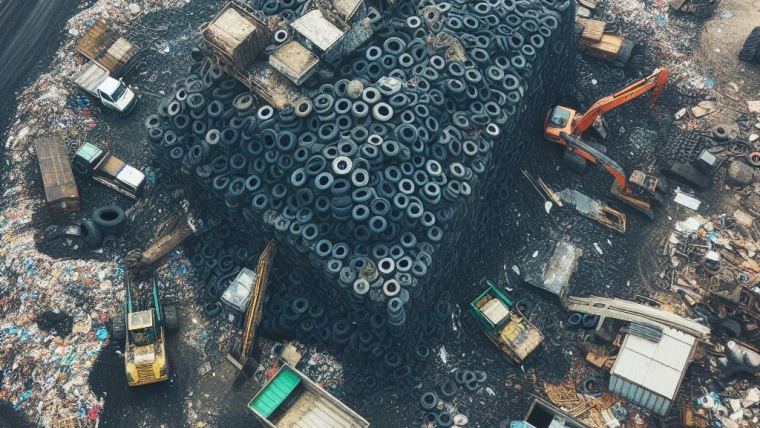
From March 1 this year, New Zealand will try again to manage a growing problem, how to dispose of and ideally, to recycle, used tyres after the existing efforts have failed.
Millions of tyres reach the end of their usable life on vehicles every year. Instead of being recycled, around two-thirds of the 7.75 million used tyres annually go into landfill, are stockpiled or simply dumped.
This creates serious environmental problems with tyre fires costing millions, mosquito breeding nuisances being created, along with poisonous leachate.
The problem has been known for years now, but the fragmented effort to reduce tyre waste has had dismal results.
A May 2015 report for the Ministry of Environment by management consultants KPMG pointed out that around 70% of waste tyres in New Zealand are disposed of in landfills “or otherwise unaccounted for”.
KPMG said in its report at the time that in Europe, less than 5% of tyres go into landfill. In the United States and Japan, the figure is below 20%.
Ad hoc tyre disposal fees charged up until now have not been effective to minimise waste, and that’s now changing under the auspices of the Tyrewise project in Hastings which it's embarking on.
Starting March 1 this year, a tyre stewardship fee of $6.65 excluding GST will be charged on all new tyres, separate or on vehicles.
That’s for standard passenger car tyres. The fee will vary depending on the type of vehicle tyre, such as those for tractors and motorcycles. Disposal fees for tyres may apply until September 1 after which date they go away.
With the disposal fee paid already, vehicle users can take up to five end of life tyres at a time to a public collection site, for no additional charge.
The scheme is estimated to collect $54 million in the first year.
Old tyres a money spinner
The Tyrewise project started in 2012, with funding from the Government, to create a product stewardship programme with industry support.
Progress on delivering an effective tyre waste minimisation scheme has been slow, with the project effectively being put on hold between 2015 and 2017 while the industry waited for a priority product declaration, which would have made the Tyrewise mandatory.
Tyres were declared a priority product in 2020, with regulation published last year. This forces anyone importing or selling eligible tyres to work with Tyrewise and its product stewardship scheme.
3R Group is the implementation manager for Tyrewise, and the organisation has put together modelling that suggests the project will have a positive impact financially, with a $34.5 million net present value (NPV).
This compares to a negative NPV of $43.3 million in a do-nothing scenario, which would see an estimated 52,561 tonnes of tyres a year go to landfill or be exported, and 3000 tonnes being illegally dumped.
Under the scheme, Tyrewise estimates that just 3000 tonnes of tyres will go into landfill or be exported, and illegal dumping cease completely. The number of tyre fires should drop from four a year to three.
Tyres will be turned into fuel, rubber asphalt, and mixed into concrete using various methods such as cryogenics to make them brittle for grinding, earning revenue instead of simply being dumped into the ground.
Already, the country’s only cement maker, Golden Bay, uses chipped tyres and wood waste to reduce its dependency on coal from Australia. Some 15% of its fuel is from tyres, and Golden Bay can use up to 30% for its needs.
Tyrewise project manager and chief executive Adele Rose told interest.co.nz the project has a positive NPV which could be even higher than originally estimated.
“Yes that’s correct, Tyrewise has a positive NPV; I suspect that it would be higher now than when the modelling was completed, purely because some of the processing entities assessed during that time have now matured and there is an increased value to them for easy to obtain end of life tyres,” Rose said.
“Primarily that is Golden Bay Cement who can pull through 30,000 tonnes of tyre derived fuel from the two main domestic processors that supply them – Waste Management (Wiri) and Treadlite (Cambridge),” Rose added.
There are also process optimisations by the cement maker that were not included in the original estimates."
“Golden Bay Cement have now produced a lower carbon intensive cement because of using tyre derived fuel as a black coal replacement, where some of the steel from the end-of-life tyre also goes through into the cement mixture – none of that was modelled at the time,” Rose said.
How well the Tyrewise 2.0 scheme works will be assessed in an updated report after the first 12 months of operation, in August 2025. Rose said Tyrewise will then be able to test some of the assumptions, and also understand how addressing the current market failures of end-of-life tyres not reaching those that process them into other products affect the modelling.
9 Comments
Sure hope it works, I had no idea that 70% are dumped or landfilled.
I would be veryInterested to know what emmisions are produced from burning tyres for fuel? They either have extreme emission reducing filters or it would be a totally environmental joke.
Same here , surely they are filtering particulates. I guess they need to weigh up coal vs tyre, either way coal is going to be burnt for making steel and concrete etc
If they're made of actual rubber they're renewable!
"“Golden Bay Cement have now produced a lower carbon intensive cement because of using tyre derived fuel as a black coal replacement,"
So there is some improvement at least. Plus, given that they are replacing imported coal, there is (as is stated in the article) less of a dependency on coal from Australia.
Exciting times.
The number of tyre fires should drop from four a year to three.
I’m supportive of the programme. Just genuinely surprised this was allowed to go ahead on National’s watch. I would have thought they wouldn’t be liking an extra $13-$20 per tyre ($52-$80 per vehicle) for utes after they went to all that trouble to repeal the ‘Ute tax’. Or just any extra costs to the consumer in a cost of living crisis.
Would be great if the transport minister Simeon Brown would endorse cycling. There'd be less tire waste. My ebike ride to work is only 5 minutes longer than by car, cost nothing to park, and is immune to congestion meanwhile, I've lost 5kg's over the last few months AND I'm saving stacks of money, made possible by separated cycle ways or else I wouldn't have done it. Just saying, great solution is just staring us in the face, while we do nothing to further this potential avenue. I'm not a "cyclist" I don't care about bike technology. I don't wear lycra, I dress for my destination. I just want to get where I want to go efficiently, and this does that.
the reason a cement works can burn rubber is it works at very high temperatures that fully combust high energy dense rubber.

We welcome your comments below. If you are not already registered, please register to comment
Remember we welcome robust, respectful and insightful debate. We don't welcome abusive or defamatory comments and will de-register those repeatedly making such comments. Our current comment policy is here.